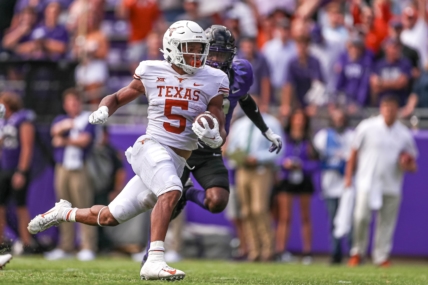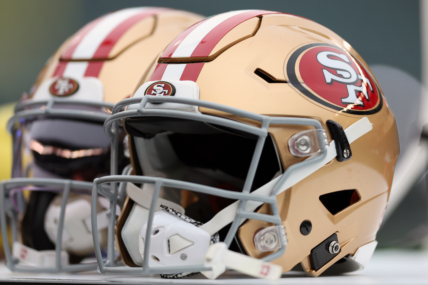Bijan Robinson. The former Texas star is considered by some to be the best overall player in the 2023 NFL Draft. Robinson’s ability to break away for a touchdown on pretty much every play coupled with his elite frame and outlandish talent has NFL personnel people salivating.
When looking at the complexion of the NFL years ago, there would be little question about Robinson’s status as the No. 1 overall pick in any given draft.
Not anymore. He plays running back. They are a dime a dozen in the modern NFL with evidence and narratives pointing in this direction on a near never-ending basis.
Consider this. The Chicago Bears and Baltimore Ravens finished No. 1 and No. 2 in rushing last season, respectively. Their leading rushers? Quarterbacks. The Atlanta Falcons finished third with fifth-round pick Tyler Allgeier and a former wide receiver in Cordarrelle Patterson leading the charge. None of these three teams had a running back who actually finished in the top five of the NFL in carries or rushing yards.
It’s the devaluation of the workhorse, three-down back that has taken over the NFL in recent years. And it will have an impact on Bijan Robinson’s draft stock once the NFL Draft comes calling. That’s not in question. The only question is how far Robinson will fall simply because of the position he plays.
While talent evaluators around the NFL pretty much all view Robinson as a top-five player in the draft, not a single one has an idea of where he is going to land. Robinson’s ceiling seems to be No. 10 overall to the Philadelphia Eagles with a floor at the end of the first round.
“I just don’t know where to put him,” one unnamed NFL general manager said.
So, what’s at the crux of this issue? How did teams get to the point of undervaluing running backs? What’s the history behind this? Let’s check in on all of that below while attempting to come to a conclusion regarding Bijan Robinson and his draft stock.
Related: Sportsnaut’s 2023 NFL Draft big board
NFL teams don’t value running backs as long-term contributors
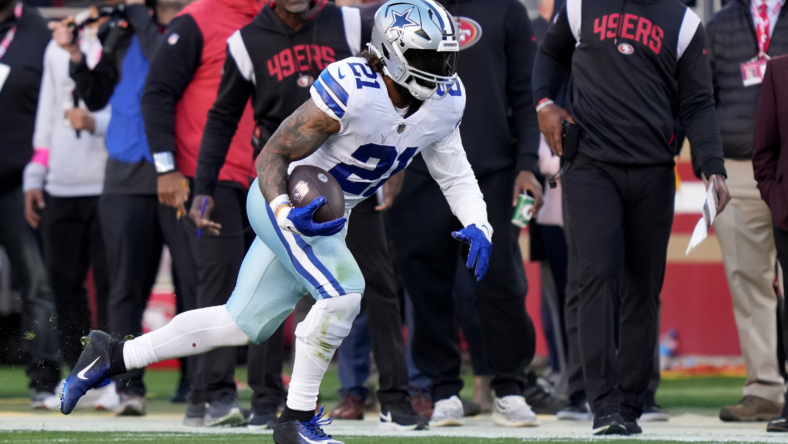
Ezekiel Elliott, Saquon Barkley, Todd Gurley, Joe Mixon and Chris Carson rounded out the running backs with the most rushing yards back in 2018. Fast forward five seasons, and only Barkley and Mixon are still with their current teams.
Elliott was released by the Dallas Cowboys earlier this offseason. Gurley and Carson are no longer even playing in the NFL. Meanwhile, Mixon will likely be released by the Cincinnati Bengals later this offseason.
In general, teams view running backs as one contract players. That is to say, letting a first-round pick play out a five-year deal while moving on from non-first-round selections after four years. The defending NFC champion Philadelphia Eagles are a prime example of this.
Despite Miles Sanders putting up a tremendous 2022 season, Philadelphia opted not to be players in a market that ultimately saw the Penn State product land a four-year, $25 million contract with the Carolina Panthers.
Eagles general manager Howie Roseman then signed former Seattle Seahawks first-round pick Rashaad Penny to a mere one-year, $1.35 million contract to be part of a backfield that includes internal options such as Kenneth Gainwell ($953,000 average salary) and Boston Scott ($1.85 million).
Remaining in the NFC East, the Dallas Cowboys were somewhat of an outlier when they inked former No. 4 overall pick Ezekiel Elliott to what was then a record-breaking six-year, $90 million contract extension back in September of 2019.
Even after releasing Elliott earlier this offseason, Dallas continued to spend on the running back position by placing the franchise tag on his incumbent, Tony Pollard, worth $10.09 million in 2023.
One might think that Dallas’ philosophy would lead to a differing opinion on Bijan Robinson and the value of drafting running backs high. Not so much.
“I think it depends on what part of the first round. If you’re up there in the top 10, it’s hard to take them there,” Dallas Cowboys vice president Stephen Jones on running back value in the NFL Draft. “You definitely, if you’re taking a player in the top half, you’re hoping you got a player that’s going to be here 10 years. And it’s tough for running backs to last 10 years. There’s not many Emmitt Smiths or guys that play that long.”
This thought process has played out in real time throughout the past several drafts. It’s an outlier to see a running back valued at a clip of other skill positions.
Related: Sportsnaut’s 2023 NFL mock draft
NFL Draft history tells us a lot about running back value
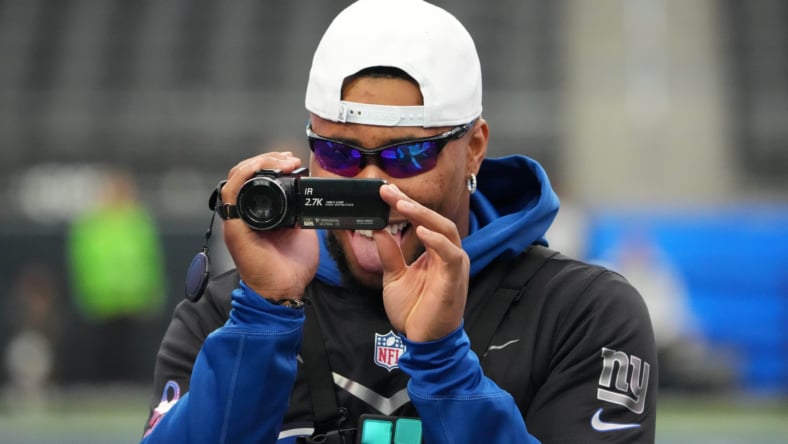
Since the New York Giants surprised everyone and took Saquon Barkley No. 2 overall in the 2018 NFL Draft, a total of four running backs have gone in the first round. The highest selections among that group were Josh Jacobs (24th in 2019) and Najee Harris (24th in 2021).
This very same span has seen 19 wide receivers picked on Day 1 with five plays selected in the top five. As for the all-important quarterback position, 13 signal callers have been picked in the first round since Barkley went No. 2 overall.
The only outlier here is tight end where three players at that position have gone in the first round over the past four years. Though, the lack of tight ends being selected within the initial round of the NFL Draft has traditionally been the case (12 over the past quarter century).
Let’s go back to a previous era of NFL football in which teams actually valued the running back position and having a three-down guy to handle the duties. That was roughly a quarter-century ago. Just take a gander of those who finished in the top-10 in rushing during the 1998 NFL season.
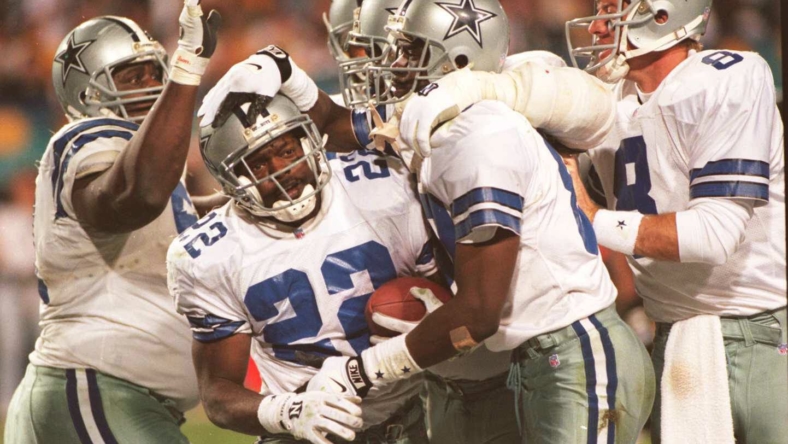
Garrison Hearst (3rd overall pick), Barry Sanders (3rd pick), Emmitt Smith (17th pick), Marshall Faulk (2nd pick), and Eddie George (14th pick) were five of the seven running backs with the most yards in the NFL.
That season also saw 11 backs compile 300-plus rushing attempts. It’s the same number of backs who have reached the 300-carry plateau since the end of the 2013 season combined. That’s a decade of football.
The days of the bell-cow backs are over. This has played a huge role in how teams value running backs such as Bijan Robinson in the NFL Draft. Look how many running backs were taken in the first round over the past several decades.
- 2010s: 16
- 2000s: 32
- 1990s: 34
- 1980s: 54
It’s now all about a committee approach. Eight of the 14 playoff teams from a season ago had multiple players put up north of 500 rushing yards. Of course, the dual-threat quarterback has played a role here.
But let’s look at that 1998 season as a case study. Of the 12 playoff teams, only one had multiple players with 500-plus yards on the ground. Four saw multiple players put up as much as 300 yards. The committee approach has indeed led to the devaluation of running backs in the modern NFL Draft.
Rushing stats and NFL Draft status
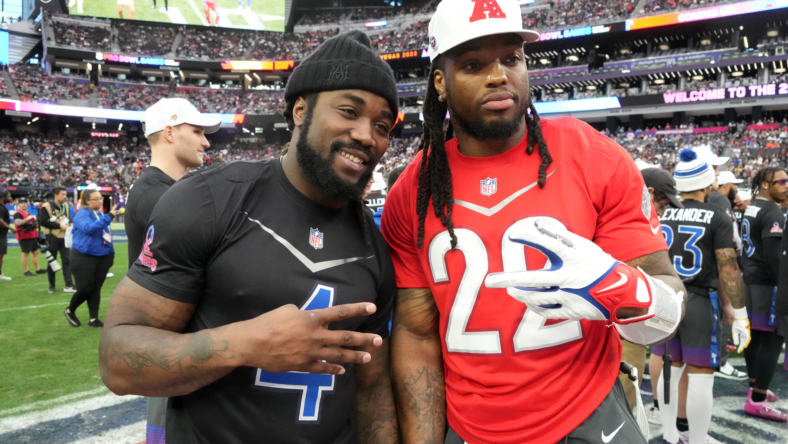
2022 NFL rushing leaders
| Player | Team | Yards | Round |
| Josh Jacobs | Las Vegas Raiders | 1,653 | 1st |
| Derrick Henry | Tennessee Titans | 1,538 | 2nd |
| Nick Chubb | Cleveland Browns | 1,525 | 2nd |
| Saquon Barkley | New York Giants | 1,312 | 1st |
| Miles Sanders | Philadelphia Eagles | 1,269 | 2nd |
2021 NFL rushing leaders
| Player | Team | Yards | Round |
| Jonathan Taylor | Indianapolis Colts | 1,811 | 2nd |
| Nick Chubb | Cleveland Browns | 1,259 | 2nd |
| Joe Mixon | Cincinnati Bengals | 1,205 | 2nd |
| Najee Harris | Pittsburgh Steelers | 1,200 | 1st |
| Dalvin Cook | Minnesota Vikings | 1,159 | 2nd |
2020 NFL rushing leaders
| Player | Team | Yards | Round |
| Derrick Henry | Tennessee Titans | 2,027 | 2nd |
| Dalvin Cook | Minnesota Vikings | 1,557 | 2nd |
| Jonathan Taylor | Indianapolis Colts | 1,169 | 2nd |
| Aaron Jones | Green Bay Packers | 1,104 | 5th |
| David Montgomery | Chicago Bears | 1,070 | 3rd |
There are only three first-round picks on this list. Delving into it further, over this three year span, only five first-round picks at the running back position have finished in the top-10 in rushing. That same span has seen as many running backs selected in Round 5 or later finish in the top 10.
Prior to pulling off the blockbuster trade for Christian McCaffrey during last season, Kyle Shanahan and the San Francisco 49ers were a primary example of treating running backs as a dime a dozen.
San Francisco has finished in the top-10 in rushing in three of Shanahan’s six seasons as its head coach. The team’s leading rusher each season tells us a story.
- 2017: Carlos Hyde (2nd-round pick)
- 2018: Matt Breida (Undrafted)
- 2019: Raheem Mostert (Undrafted)
- 2020: Jeff Wilson (Undrafted)
- 2021: Elijah Mitchell (6th-round pick)
- 2022: Christian McCaffrey (Trade)
Noticing a theme here? San Francisco has had a different leading rusher in each of Shanahan’s first six seasons.
Heck, the team didn’t even yield a first-round pick in trading for one of the best all-around running backs in the NFL, Christian McCaffrey. Instead, the Carolina Panthers received picks in the second, third, fourth, and fifth rounds.
Historically, selecting a running back early doesn’t lead to success
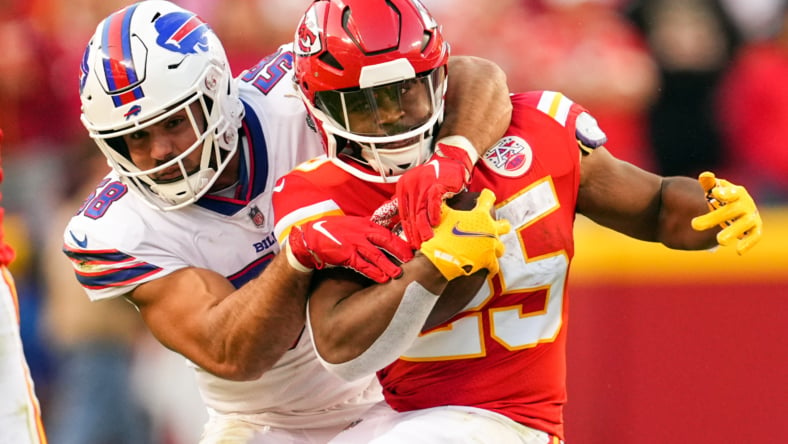
Let’s take a look at the 14 playoff teams from a season ago. Of that group, only four teams boasted a first-round pick as a leading rusher. This included Leonard Fournette putting up less than 700 yards on the ground for a historically bad Tampa Bay Buccaneers rushing offense.
Super Bowl LVII pitted Philadelphia Eagles running back Miles Sanders (second-round pick) against rookie seventh-round selection Isiah Pacheco of the Kansas City Chiefs. The two combined to put up 92 rushing yards. Quarterbacks Patrick Mahomes and Jalen Hurts combined for 114 yards on the ground.
Back in 2021, there were also only four teams who made the playoffs who were led by first-round picks on the ground. What about 2020? One team. That came in the form of Clyde Edwards-Helaire of the Kansas City Chiefs, who was replaced as their lead ball-carrier by the aforementioned Pacheco in less than two years.
Related: Highest-paid NFL running backs of 2023
Finding real value at the running back position in the NFL Draft
Here’s a list of the six running backs who have been selected in the first round of the NFL Draft over the past five years:
| Year | Player | Team | Pick |
| 2018 | Saquon Barkley | New York Giants | 2nd |
| 2018 | Rashaad Penny | Seattle Seahawks | 27th |
| 2019 | Josh Jacobs | Las Vegas Raiders | 24th |
| 2020 | Clyde Edwards-Helaire | Kansas City Chiefs | 32nd |
| 2021 | Najee Harris | Pittsburgh Steelers | 24th |
| 2021 | Travis Etienne | Jacksonville Jaguars | 25th |
There is a common theme here. By and large, teams value dual-threat running backs in the NFL Draft. That is to say, prospects who can make nearly as much of an impact in the passing game as running the ball.
Including his 57 receptions last season, Barkley has recorded 247 catches in five seasons (60 games). The NFL’s reigning rushing king, Jacobs has registered 107 catches over the past two seasons for Vegas. Harris has 115 catches in two NFL seasons while Etienne caught 35 passes in his first season of action after the former Clemson star missed his entire rookie season to injury.
The two outliers here are Penny and Edwards-Helaire, both of whom were seen as big time reaches when their teams selected them in the first round. Due to injuries, Penny played in all of 42 games in five seasons with the Seahawks — catching a combined 27 passes. CEH? He’s been a downright bust in Kansas City, but has still been able to tally 72 catches in 33 career games.
It really isn’t brain surgery. Teams that have had success in recent years boast dual-threat running backs, most of whom were not among the top-32 picks in the draft.
Those who didn’t have that dual threat, opted to move off the incumbent. Philadelphia’s decision not to retain Miles Sanders in free agency is a prime example of this. Heck look at the reception numbers for each playoff team’s leading rusher a season ago.
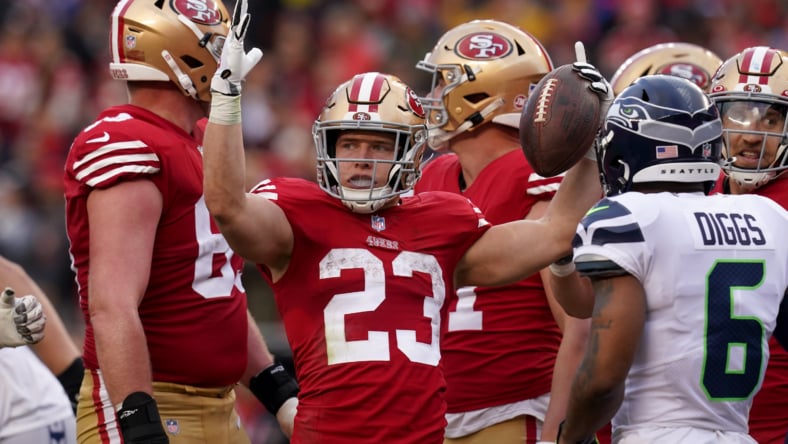
| Team | Player | Receptions |
| Los Angeles Chargers | Austin Ekeler | 107 |
| San Francisco 49ers | Christian McCaffrey | 85 |
| Tampa Bay Buccaneers | Leonard Fournette | 73 |
| Cincinnati Bengals | Joe Mixon | 60 |
| New York Giants | Saquon Barkley | 57 |
| Minnesota Vikings | Dalvin Cook | 39 |
| Dallas Cowboys | Tony Pollard | 39 |
| Buffalo Bills | Devin Singletary | 38 |
| Jacksonville Jaguars | Travis Etienne | 35 |
| Seattle Seahawks | Kenneth Walker | 27 |
| Philadelphia Eagles | Miles Sanders | 20 |
| Baltimore Ravens | Kenyan Drake | 17 |
| Kansas City Chiefs | Isiah Pacheco | 13 |
- The Chiefs boasted a catch-first back in veteran Jerick McKinnon who recorded 56 receptions last season.
- The Ravens were injury plagued at running back throughout the 2022 season. Outside of quarterback Lamar Jackson (764 yards), their leading rusher was Drake with 482 yards.
- Of these 14 running backs, four are no longer with their teams. Of the remaining 10, two had the franchise tag placed on them rather than being handed long-term deals.
- Austin Ekeler has demanded a trade after Los Angeles refused to sign him to an extension. Dalvin Cook will soon be traded or released by the Vikings. Unless he takes a pay cut, Joe Mixon will be released by the Bengals.
- Only Christian McCaffrey, Dalvin Cook, Joe Mixon, and Saquon Barkley were among the 10 highest-paid running backs in the NFL last season.
What does this tell us? Successful teams are not valuing running backs at a high clip. Those that do value have the ability to add a whole lot to the passing game.
Related: NFL Draft rumors: What the S2 scores really mean, plus Trey Lance trade talk and more
Teams value offensive line more than running backs
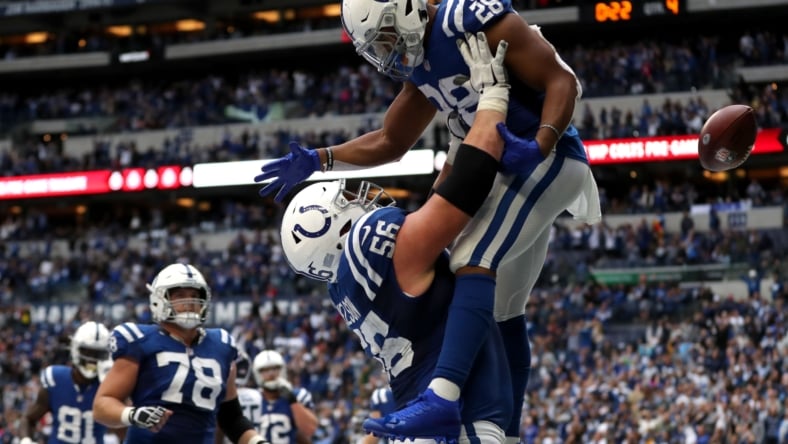
We’re not necessarily talking franchise left tackles. That has been the case since the unfortunate career-ending injury then Washington quarterback Joe Theismann suffered back in 1985. Heck, it even spawned a blockbuster movie.
Rather, we’re talking interior offensive linemen. A total of 13 guards and centers have been selected in the first round over the past five drafts. We’re expecting a couple more to go this week.
For NFL teams, it makes a lot of sense. Why not value players who can suit up and play at a high level for a decade-plus over those with shorter shelf lives?
Related: Bijan Robinson scouting report and NFL Draft profile
The case for and against Bijan Robinson in the 2023 NFL Draft
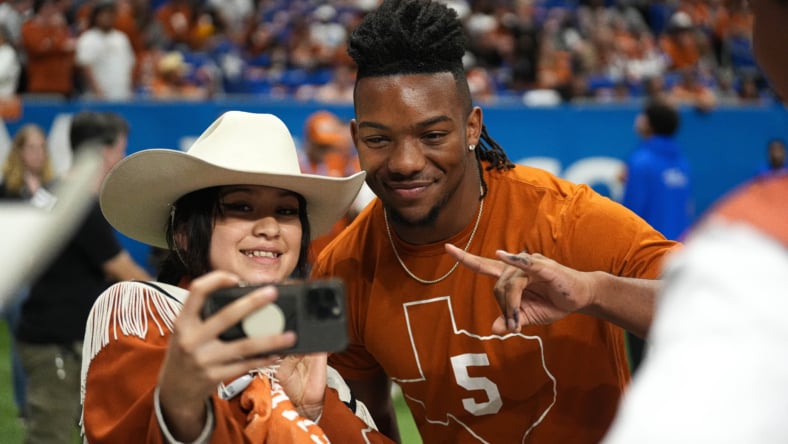
It’s not a secret that Robinson is seen as one of the most dynamic backs to enter the NFL in decades. Comparisons have been made to future Hall of Famer Adrian Peterson who was selected by the Minnesota Vikings No. 7 overall back in 2007.
- Bijan Robinson stats (2022): 258 attempts, 1,580 yards, 6.1 average, 19 receptions, 314 yards, 20 TD
Robinson’s 19 receptions from a season ago are misleading. He is indeed seen as a legitimate threat in the passing game, which is one of the reasons why teams view the former Texas star as a potential franchise cornerstone.
“Full-menu back blending a smorgasbord of position-specific traits that allow him to affect games. Robinson is well-built with a compact lower half and pairs a low center of gravity with agile feet.
There are elements of both fight and flight in his running style, but defenders can never be quite sure what they are going to get. He’s a capable inside/outside runner with unique footwork to stack moves and reset pathways, but can plow into tacklers at a moment’s notice using elite contact balance to keep the run rolling.”
NFL Media scouting report on Bijan Robinson
That’s the case for Robinson. He’s going to be an All-Pro talent out of the gate. Perhaps, the best all-around running back in the NFL as a rookie.
However, we have to look at value when taking into account Robinson’s stock. Sportsnaut’s NFL insider Benjamin Allbright indicates that some around the league believe Robinson can go as high as No. 8 to the Atlanta Falcons.
Set to rely on young quarterback Desmond Ridder under center next season, it makes sense to add an elite back. Even then, they did finish third in the league in rushing a season ago with their current crop of backs. Looking to expedite their rebuild, it makes little sense for the Falcons to “reach” for a running back.
We can pretty much cross out the Philadelphia Eagles at 10. Sure they have been linked to Robinson. But that really isn’t general manager Howie Roseman’s MO. He values the Eagles’ blocking scheme and offensive line over running backs. The departure of Miles Sanders is a primary example of this.
It’s more realistic to believe that Philly is linked to Robinson with its original first-round pick (30th overall). These are the only two realistic options within the top 10 for Bijan Robinson.
The likelier scenario is that Robinson falls to the second half of Round 1. The Detroit Lions (18th), Tampa Bay Buccaneers (19th), Los Angeles Chargers (21st), Minnesota Vikings (23rd), Buffalo Bills (27th), and Philadelphia Eagles (30th) are all potential fits.
It’s now all about the waiting game. Robinson is one of the top storylines leading up to the NFL Draft. Should he fall down the board, the league’s history of devaluing this position will rear its ugly head once again Thursday evening in Kansas City.
See exclusives Sportsnaut videos on Instagram, YouTube, and TikTok.
